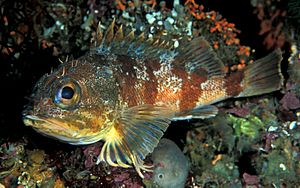Microcotyle victoriae facts for kids
Quick facts for kids Microcotyle victoriae |
|
|---|---|
| Scientific classification | |
| Genus: |
Microcotyle
|
| Species: |
victoriae
|
| Synonyms | |
|
|
Microcotyle victoriae is a tiny species of worm-like animal. It is a parasite, which means it lives on and gets its food from another animal. This specific parasite lives on the gills of marine fish. It belongs to a group of parasites called Monogenea and is part of the family Microcotylidae.
Contents
Discovering Microcotyle Victoriae
Microcotyle victoriae was first described by a scientist named Woolcock in 1936. In the same year, Woolcock also studied another similar parasite called Microcotyle bassensis. Scientists sometimes change the names of species as they learn more about them. For example, Microcotyle victoriae was once placed in a different group called Paramicrocotyle. However, after more research, it was moved back to the Microcotyle group, which is where it is now.
What Microcotyle Victoriae Looks Like
Microcotyle victoriae has a flat, thin body. It is symmetrical, meaning both sides are mirror images of each other. The body has two main parts: a front part where most of its organs are, and a back part called the haptor.
The Haptor and How it Attaches
The haptor is a special part at the back of the parasite. It is clearly separate from the rest of the body. This haptor has between 17 and 25 pairs of tiny "clamps." These clamps are arranged in two rows, one on each side. The clamps are very important because they help the parasite hold onto the fish's gills.
Other Body Parts
At the front of its body, Microcotyle victoriae has two almost round "buccal suckers" near its mouth. These suckers also help it attach. Its mouth is at the very front and has a folded lip. Inside, it has a small, round, muscular pharynx (like a throat) and an intestine with two branches. Like many parasites, each adult Microcotyle victoriae has both male and female reproductive organs.
Where the Name Comes From
The specific name victoriae comes from Victoria. This is the place in Australia where this species was first found.
Where it Lives and What it Eats
The only known host for Microcotyle victoriae is a fish called the red gurnard perch, also known as jock stewart (scientific name: Helicolenus percoides). This means the red gurnard perch is the only type of fish this parasite has ever been found living on. So far, Microcotyle victoriae has only been found off the coast of Australia.


